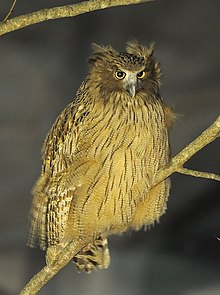Blakiston's fish owl
| Blakiston's fish owl | |
|---|---|
 |
|
| Scientific classification | |
| Kingdom: | Animalia |
| Phylum: | Chordata |
| Class: | Aves |
| Order: | Strigiformes |
| Family: | Strigidae |
| Genus: | Bubo (but see text) |
| Species: | B. blakistoni |
| Binomial name | |
|
Bubo blakistoni Seebohm, 1884 |
|
Blakiston's fish owl (Bubo blakistoni), the largest living species of owl, is a fish owl, a sub-group of eagle owls who specialized in hunting riparian areas. This species is a part of the family known as typical owls (Strigidae) which contains most species of owl. Blakiston's fish owl and three related species were previously placed in the genus Ketupa; mtDNA sequence data is equivocal on which genus name is applied for this species. Its habitat is riparian forest, with large, old trees for nest-sites, near lakes, rivers, springs and shoals that don't freeze in winter. Henry Seebohm named this bird after the English naturalist Thomas Blakiston, who collected the original specimen in Hakodate on Hokkaidō, Japan in 1883.
It is more correct to call this species the Blakiston's eagle owl. This is because it is more closely related to the Eurasian eagle-owl by studies of the main subgenus of the species, B. b. dumeril, than to the subgenus of fish owls that it was believed to be more close to, i.e. Ketupu. This was proven by osteological (skeleton/bone-related) and DNA-based tests in 2003 by ornithologists/taxonomists Michael Wink and Claus König, author of Owls of the World. However, the other fish owls are not believed to be divergent enough to support a separate genus either and now all fish owls are generally also included in the Bubo genus. Given that it shares genetic material osteological characteristics with the eagle-owl and also seems to share some characteristics with the other three fish owls (especially the brown species), the place of the Blakiston's fish owls in this evolutionary chain is ambiguous. Some authors have wondered whether the Blakiston's represents an intermediate step between traditional eagle-owls and the other fish owls, despite the current gap in distribution between Blakiston's and other fish owls. Whether other Asian eagle-owls with sideways slanting ear-tufts, namely the spot-bellied (B. nipalensis), the barred (B. sumatranus) and especially the somewhat superficially fish owl-like dusky eagle-owl (B. coromandus) are closely related to the fish owls and/or the Blakiston's is also unclear. Despite a few authors also include them in Bubo, the fishing owls of Africa, generally classified in the genus Scotopelia, seem to be unrelated in every major way, based on external characteristics, oseology and preliminary genetic materials, to the fish owls and it is unclear how, and if, they are related to typical eagle-owls.
...
Wikipedia

